Last edit by: IB Advertising
See related guides and technical advice from our community experts:
Browse all: Specifications & General Maintenance
- Jeep Cherokee 1984-2001: Off-Roading Tips and Tricks
Important information to help you understand your Jeep Cherokee
Browse all: Specifications & General Maintenance
LOW COG suspension setup tricks/tips (REVISED 9-24-12)
#1
First off I do not consider myself an expert on the matter, but I have a few years of experience in "low cog" setup xjs. I often have people asking me "ZOMG HOW DO YOU GET ALL THAT FLECKS WITH THOSE BIG TARZ AND LITTLE LIFT!?!?!11!!77!" so i figure its a good time to make a thread I can point people to when I am asked this question. I realize people may disagree with my ideas and experience, but thats expected, everybody has an opinion. There is no perfect rig out there, and where a low cog setup may suffer, a taller rig may make the obstacle look easy. I'm just here to share the knowledge I have acquired over building, wheeling, and competing the 3 xj's I have owned over the past several years.
I will make this post in a frequently asked question format. Feel free to ask questions in this thread, and I will add to this post as they arise.
_____
Why do I want a low center of gravity?
The main advantage to being low is stability. This stability benefits you on hillclimbs, descents, in the rocks, in off camber situations, on the street, even at speed offroad, and just about anywhere really. Lots of soft and flexy suspension travel used to be all the rage, but lately the train of thought is that the most capable rigs are low to the ground with large tires, and a predictable suspension, with a reasonable amount of travel. Ever notice that most competition buggies are low to the ground with very little suspension compression? Ever notice that even trophy trucks that see regular airtime are low to the ground? Granted their suspensions are worked more than most of us will ever imagine in our xj's the same ideas can be used to our advantage.
Here are a couple situations where Im sure I would have had a bad time If I was much taller than I already was just to give you a feel for what a lower center of gravity is capable of.
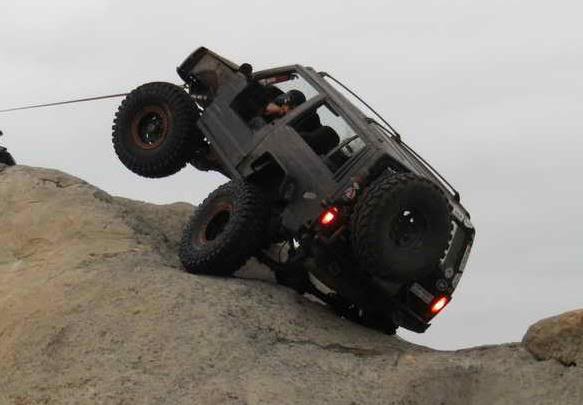
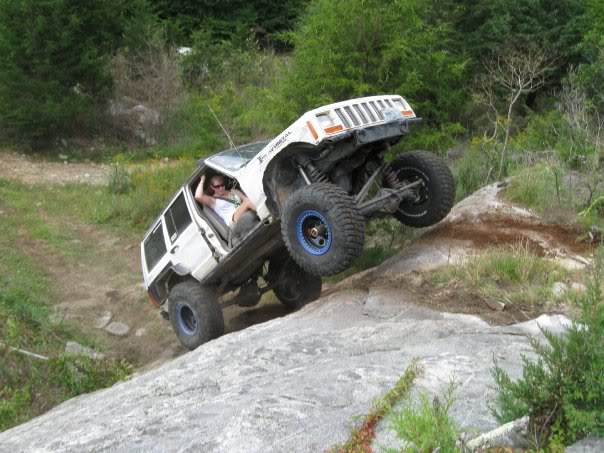
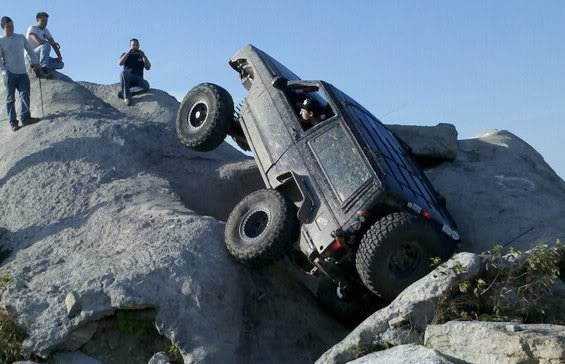
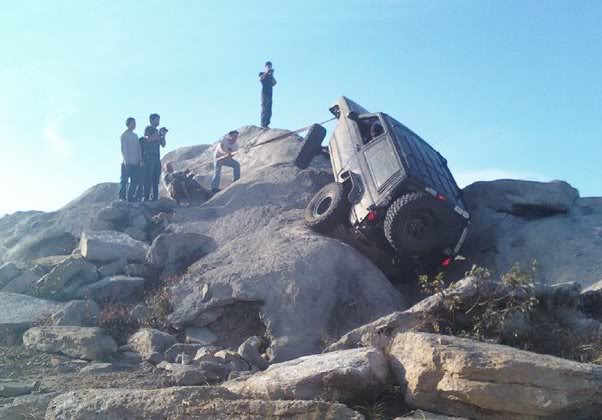
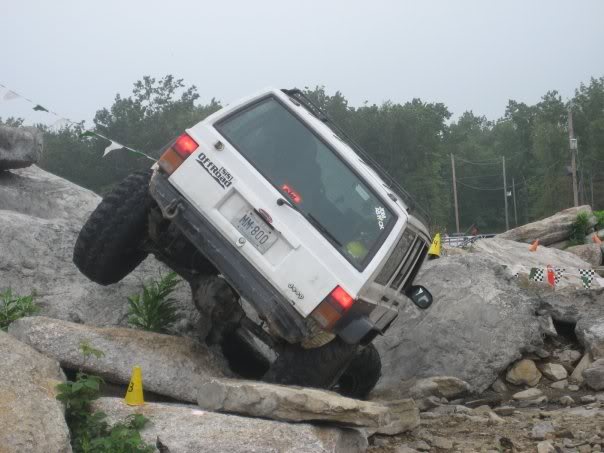
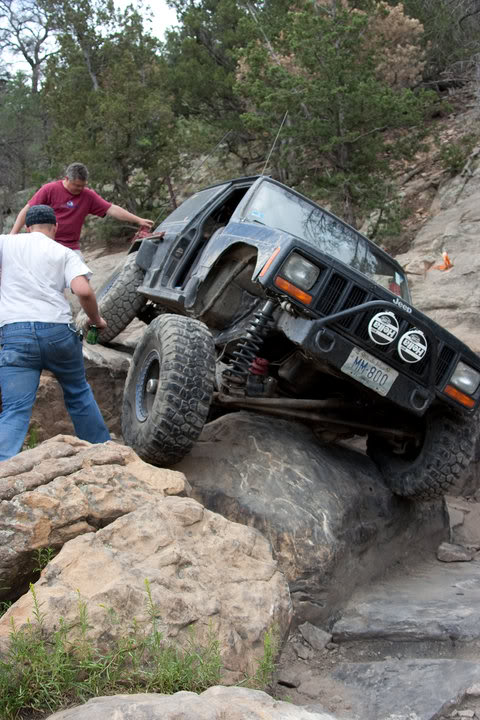
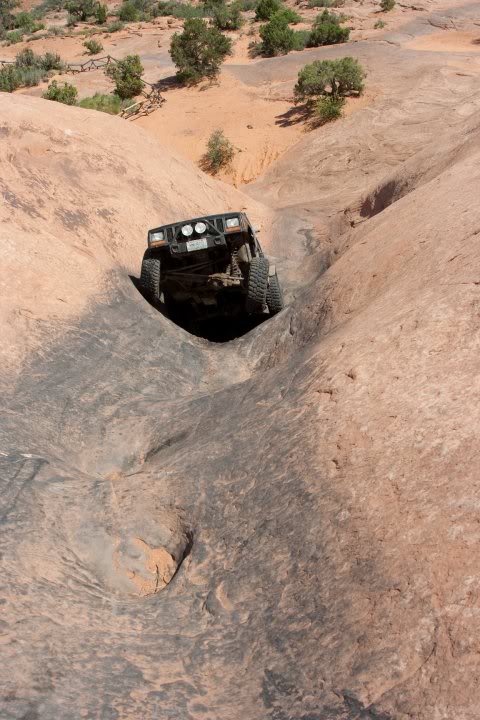
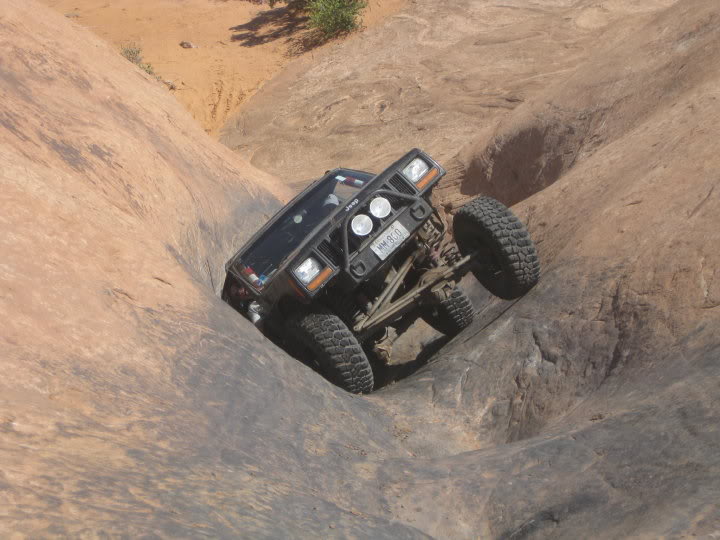
______
Weight transfer? Whats that?
Weight transfer occurs mostly on hillclimbs, but the same is true for descents and off camber situations. But its easier to explain when thinking of a hillclimb, so lets talk about hillclimbs.
As you approach a steep incline, the steeper you go, the more weight gets positioned over your rear tires than your front. The taller you are, the more weight ends up towards the rear tires. If the exact center of gravity of the vehicle (usually right around the top of the transmission bell housing) crosses over the rear axle, that is a recipe for tipping end over end, same goes for off camber, and descents, if the exact center of gravity crosses over the point your tires come in contact with the ground, carnage will generally ensue. Even if you don't wheel anything too extreme and don't think you have to worry about that much, the taller you are, the less weight is positioned over your front tires when climbing, and the less effective your front tires will be at finding traction.
Here is one of the steeper climbs I have made. I would have never tried it, but it was a bonus gate in a competition I was in. The xj shot right up it while every other rig either rolled, had to bring out a strap, or go around.
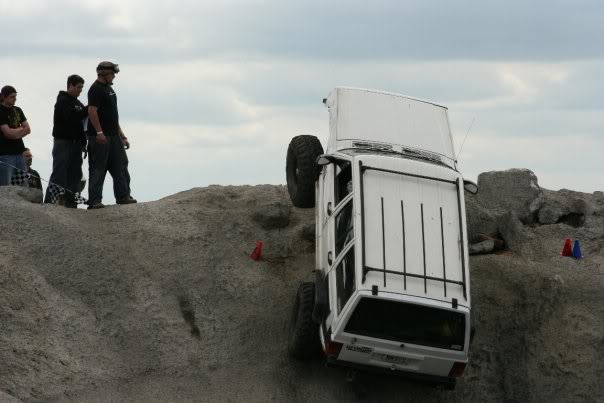
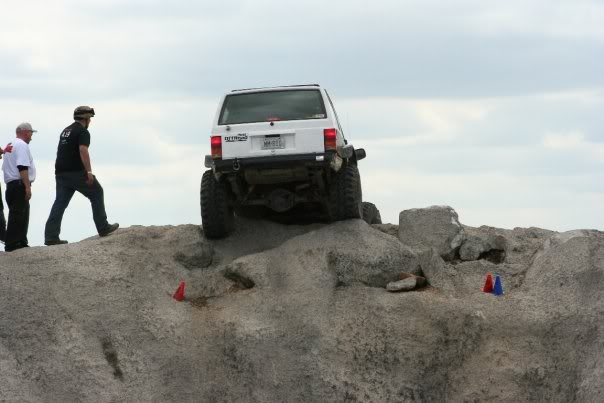
here is also an off camber obstacle on another shot, I found the tipping point of the xj shortly after this picture was taken, and was able to drive out of it.

for reference, here is how the rig sat during those competitions. About 2.5” and 37s.
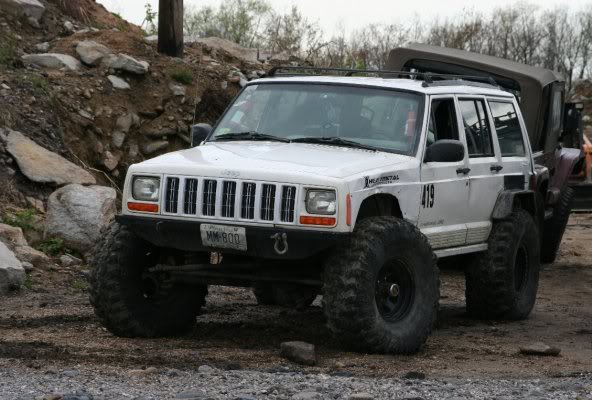
______
Wouldnt a taller lift give me more flex?
Flex isn't limited by suspension height, its limited by the components you use in your suspension. Bigger lifts call for more components to be safely run at that height, and this is why an out of the box 3" kit won't net you the same flex as an out of the box 6.5" longarm. Put many of the components from the 6.5" longarm lift on your 3" springs, and you will have a rig that flexes very similarly to it's taller counterpart (in many cases even better).
A flatter leaf spring allows more suspension travel than a taller, highly arched leaf spring. With a linked type suspension a flatter control arm angle will allow superior suspension droop over a control arm that is already at a steep angle to begin with.
______
Wouldnt bumpstops severely hurt my flex?
While it is true that bumpstops will keep your suspension from compressing, it doesn't necessarily have to HURT your flex. For example, if you are running a 3" lift, generally they come with 8" travel shocks, and these lifts are designed to stop compressing before the shocks bottom out. But if you add 2" more bumpstop to this to help clear larger tires, you can effectively run a 10" travel shock with no fears of bottoming them out. If the rest of the components in your suspension are up to it, the 2" of travel you lost in compression, you more than regained with 4" of added droop.
Now i'm sure some will ask, "How does getting 2" more shock travel mean 4" more droop? But when you add the 2" of extra bumpstop, and the 10" travel shock, the body of the shock is about 2" longer, so it cannot compress that 2" we lost in the uptravel department. The added 2" longer body, combined with the 2" extra travel will allow this 4" of extra droop.
Bumpstops can also help your flex, if you have any bind in your suspension (running a 4 link, or radius arm design in most cases) the solid axle acts as a see-saw, with the bumpstop making contact acting as the pivot point. Once one side of the axle contacts the bumpstop, the other side will begin to be forced down. This "see-saw" action will continue until a suspension component on the drooping side limits it (usually a shock).
For example, here is 4” of lift and 37s.
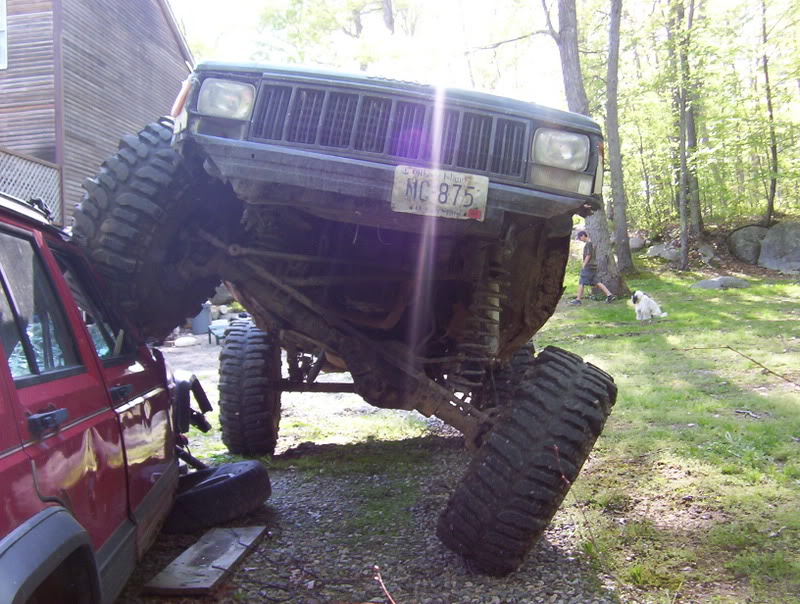
The drivers side shock is disconnected, and at this point the front driveshaft was binding and coil was about to fall out, I could have fit quite a long shock in there and kept going if my driveshaft was up to it, but this much flex is useless just about everywhere but the rti ramp.
There are also other methods to get more shock travel out of your suspension, involving custom mounts, shock hoops, inboarding, etc, but there is simply way too much to touch on that subject for this thread.
______
I have 32's with a 6" lift and STILL rub at full flex, how do you get away with it?
Lift height doesn't make your wheel openings larger, your suspension will still end up compressing to the stock bumpstops, meant for a stock sized tire. Trimming is mandatory for larger tires if you want full use out of your suspension travel. If you are afraid of trimming, then having a capable rig probably isnt high on your prioroty list and you should stop reading this post now. Trimming combined with bumpstops allowed me to run 37's effectively on a 2.5” lift with plenty of articulation.

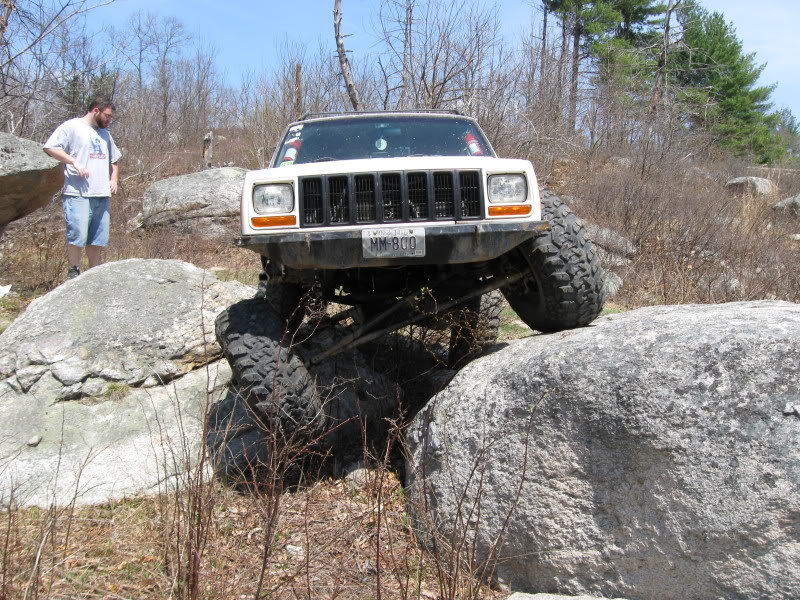
______
How much do I have to trim?
Now I have noticed many people trim much more than they need to and give the reputation that in order to run a “low cog” setup you have to “hack” your fenders apart. To each his own, but I find this untrue. You be the judge.
5” and 37's
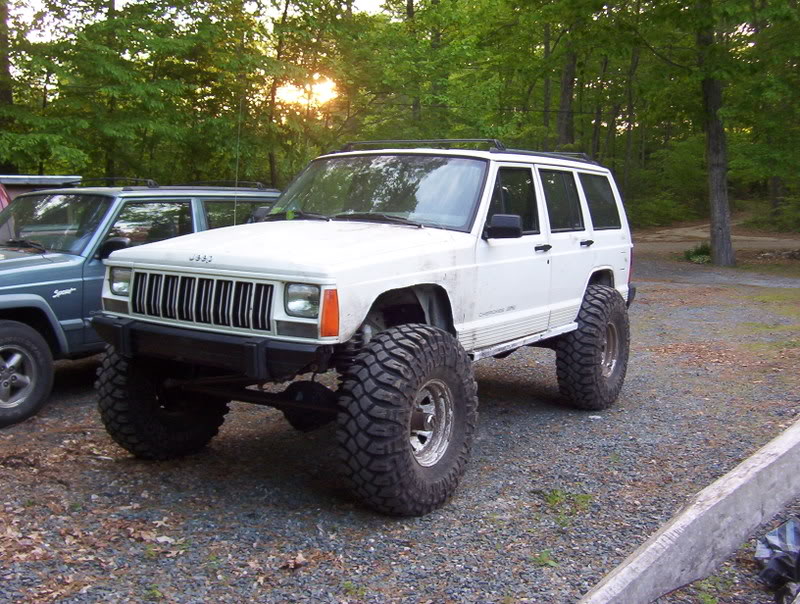
In the rear I have actually never done any trimming. I simply remove the stock fender flare, and cut 4 slits in each side. 2 at each corner of the wheel opening, and fold the sheet metal in. This keeps the unibody structure intact, and I have found it fits a 35-36 inch tire perfectly, and 37 to 38 if you do a little sheet metal “massaging” with a hammer. Of course, this is with the addition of a bit of bumpstop.
As for the front, my usual method is to outline the stock flare before taking it off (along with the plastic fender liner) and trim on that line. (careful if you have a 97+ xj with the washer fluid resivoir in the drivers fender. I have relocated mine into the engine compartment using a renix era resivoir) After proper bumpstopping, I just take a little bit off at a time until it clears. There is also a pinch seam in the front, just like the rear, you can cut a couple slits in it, and fold it flat and out of the way.
______
I can't get my leaf springs to flex as well as my coils, what can I do?
First you need to admit that you arent going to get a conventional leaf spring setup to flex as well as a built, front linked suspension found in jeeps. But you can still get the back end to do a decent job back there. Firstly, most off the shelf lift kits are tuned mostly for suspension compression. While running large tires on that lift in small wheel openings (specifically xj's) you will have to limit your uptravel. You can either cut open your xj body and do some fabrication, or decide to make your suspension droop. Keys to this are running as flat leaves as possible and having a good shackle angle. A good shackle angle is one that is about 45 degrees acute to the leaf spring, this still allows for some compression, but allows for MUCH more unrestricted droop, as well as a nicer ride quality. You can get a decent shackle angle by either running longer leaf springs, or relocating the upper mounting point forward on the vehicle, there are weld-on shackle reloaction brackets available.
Here are some pics of my xj with a 45 degree shackle angle
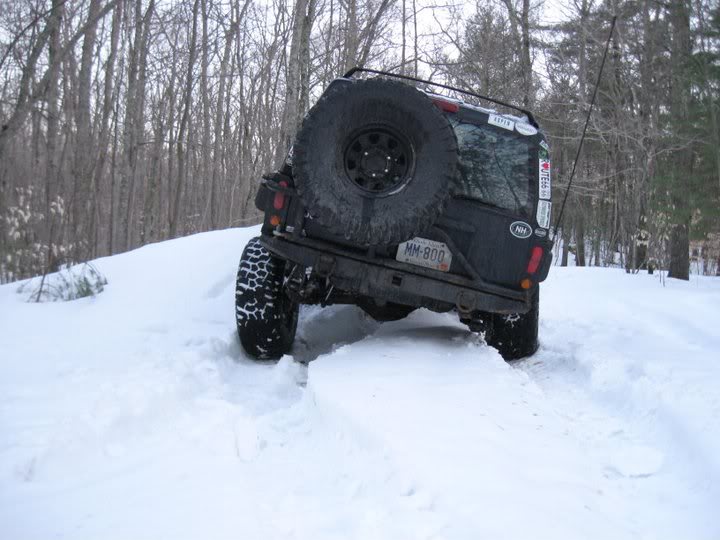
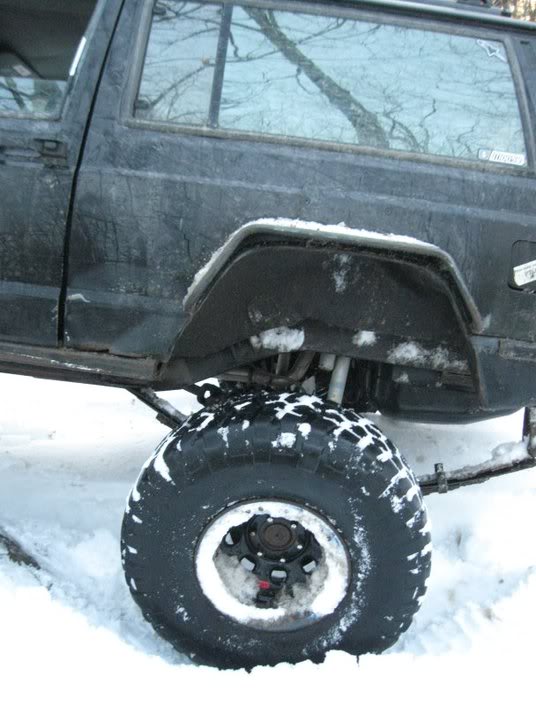
As for the leaf pack itself. a pack consisting of several thin leaves yields the best results for flex. and more leaves will also aid in keeping axle wrap under control. Some people go the extra mile and coat the leaf springs with a special anti-friction paint and leaf spring slider pads before leaf pack assembly as well. Personally, I have never done either of those, and never saw the need to.
______
What is limiting my front suspension's flex?
There are too may scenario's here for me to list them all. but I'll run through the stock components that will hinder flex. This pertains to a stock xj 4 link front end with a dana30 axle.
1- stock front swaybar. get swaybar disconnects or remove it for the trails.
2- stock shocks (when you do this remember to lengthen your brake hoses as well)
3-lower control arms. it's not the bushings that always hurt the flex, but the fact that they hit the shock mounts on the stock dana30 front end will limit your suspension droop. most aftermarket arms will either have a bend in them or an offset bushing to compensate for this.
4- stock trackbar, there is a certain point where it will either bind at the frame end tie rod end, or the bracket at the axle end.
5- shortarms. time to go to longarms or a well built midarm setup if you want more flex.
6-stock steering, it isnt adequate for any wheeling anyway and should have been ditched before the longarms.
7- driveshaft, although most people should never have to worry about this.
_______
What about clearance?
With a lower lift height this can become an issue for some. But there are things you can do about it.
First are to put a skid plate protecting any vunerable component under your jeep. With lockers at each end and a flat belly with high clearance rocker guards I have been able to finesse my way over obstacles and very rarely do I get hung up. Sometimes I even bump the front tires and purposely get the front end up in the air, which has given me mixed results, but sometimes is the only way of getting over some obstacles.
With the stock np231 transfer case commonly found in xj's a flat belly is a reality. You can get clocking kits, or simply redrill the mounting holes in the transmission output housing a few degrees over to “twist” the transfer case perfectly flat and above the bottom of the framerails. (DO NOT ATTEMPT THIS UNLESS YOU ABSOLUTELY KNOW WHAT YOU ARE DOING, if you don't get the holes perfect, you will not be able to get the t-case mounted, or you could put stress on the output bearing and seal, causing leaks, or internal transmission problems) I personally made a small jig to accurately do this to my xj, and I still was a little off and had to enlarge a couple holes, but it worked.
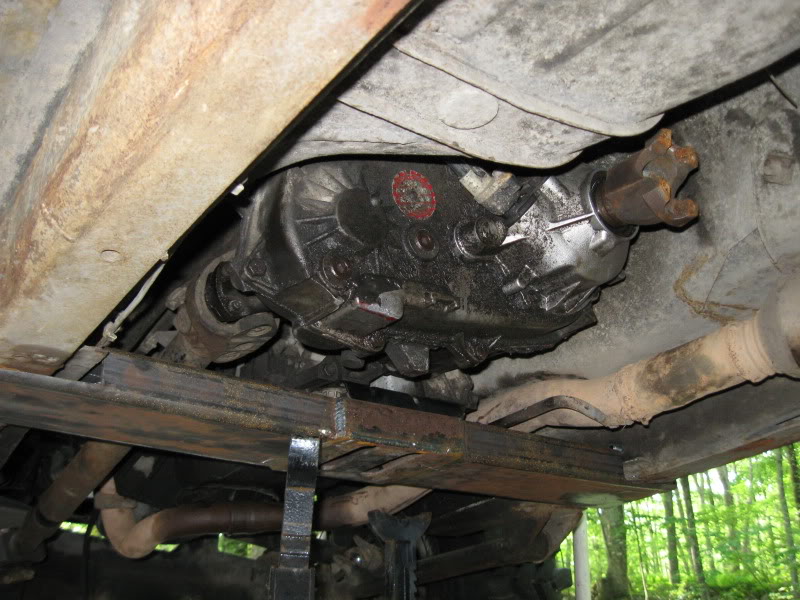
(please don't make fun of my leaky t-case, it was taken care of shortly after this pic)
Some high clearance bumpers will also do wonders for your approach/departure angles.
Replacing your rocker panels with 2x6 box steel is also a common modification, and gives more ground clearance than traditional rocker guards. (the white and black xj's in this post are equipped with 2x6 rocker panels) if you bounce them off rocks hard and often, you really should consider tieing them into the unirails.
_________
What about going fast? don't I need uptravel for that?
Short answer: yes. You are going to have a hard time building a low cog xj to handle the whoops like a jeepspeed-esque rig, but there are some things you can do to make your time at speed more enjoyable.
I have played with springs, and while a stiffer spring does help, it doesn't come close to the improvement I have noticed by running a quality, stiffly valved shock. Now shock valving is another thread altogether, and I am nowhere near an expert on that, but I have learned that while bilsteins 255/70 valving commonly found in their 51xx shock absorbers is nice for a budget shock, a much heavier valved 2.0 makes a world of difference. Just because a shock is valved stiff, doesn't mean it will ride badly. It means less jostling around on the trails, when you hit bumps at speed on the street and offroad the suspension will return to its normal ride height much quicker as opposed to making a few oscillations before returning to that state.
A big thing to help is the right bumpstops.
I am a huge fan of progressive bumpstops, even if you arent into going fast, they can make a world of difference when rockcrawling. We often come down large ledges and bounce around quite a bit and whatnot.
I am a fan of using the poly progressive bumpstops in back like seen here:
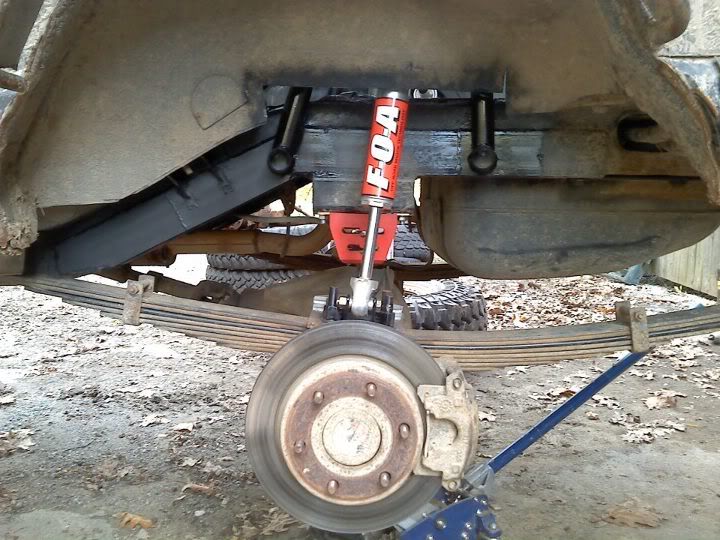
real easy to mount, and real easy to space away from the framerail. Those pictured are 3.5” tall, but they come in heights from 2.5” to 4.5” I believe.
The front is another animal, Many have tried prothane coil spring inserts (search for it) they simply float inside the coil, and some people have made modifications to soften them up even more, or stiffen them up.
The absolute best option, is air bumpstops. They are essentially a shock, filled with nitrogen and shock oil, but they are charged to slow the suspension upon impact, not just slow the suspension throughout travel. They come in lengths from 2 to 4” (usually) although many say 4's are useless on an xj, and you will be riding on them constantly. Mounting them is another thread altogether, but many reinforce the stock bumpstop tower and mount them in place of that.
_________
What exactly are the benefits of a flatter control arm angle?
This is broadening the topic at hand, but still relates to low cog suspension setup.*
In short my biggest complaint from running shortarms is approaching ledges. in order for the front suspension to compress the back tires need to slip backwards.
Imagine a tall shortarm lift. The control arms are at a 45* angle and you approach an obstacle at greater than a 45* angle. The only way the front suspension will compress is if the other drive tires slip backwards. Same if you have control arms at a 30* angle and the obstacle is greater than a 70* incline. The front suspension will want to stay unloaded until those tires are up and over that obstacle/ledge. This can make for some interesting 3 wheeled moments with the front end up in the air. The flatter the control arm angle, the more unrestricted the movement, and the steeper the obstacle you can climb while keeping all 4 tires firmly planted. It is also less stressful on steering components and axles.
Here is a quote I found that help explain this better:
Aside from that there are the obvious ride quality improvements along with more unrestricted articulation.
Like I said before, I will gladly answer questions posted in this thread, in fact I would prefer them here, and not in private message. If one person has a question, chances are more people have the same question, and I would like that question to be visible by all.
Enjoy!
I will make this post in a frequently asked question format. Feel free to ask questions in this thread, and I will add to this post as they arise.
_____
Why do I want a low center of gravity?
The main advantage to being low is stability. This stability benefits you on hillclimbs, descents, in the rocks, in off camber situations, on the street, even at speed offroad, and just about anywhere really. Lots of soft and flexy suspension travel used to be all the rage, but lately the train of thought is that the most capable rigs are low to the ground with large tires, and a predictable suspension, with a reasonable amount of travel. Ever notice that most competition buggies are low to the ground with very little suspension compression? Ever notice that even trophy trucks that see regular airtime are low to the ground? Granted their suspensions are worked more than most of us will ever imagine in our xj's the same ideas can be used to our advantage.
Here are a couple situations where Im sure I would have had a bad time If I was much taller than I already was just to give you a feel for what a lower center of gravity is capable of.








______
Weight transfer? Whats that?
Weight transfer occurs mostly on hillclimbs, but the same is true for descents and off camber situations. But its easier to explain when thinking of a hillclimb, so lets talk about hillclimbs.
As you approach a steep incline, the steeper you go, the more weight gets positioned over your rear tires than your front. The taller you are, the more weight ends up towards the rear tires. If the exact center of gravity of the vehicle (usually right around the top of the transmission bell housing) crosses over the rear axle, that is a recipe for tipping end over end, same goes for off camber, and descents, if the exact center of gravity crosses over the point your tires come in contact with the ground, carnage will generally ensue. Even if you don't wheel anything too extreme and don't think you have to worry about that much, the taller you are, the less weight is positioned over your front tires when climbing, and the less effective your front tires will be at finding traction.
Here is one of the steeper climbs I have made. I would have never tried it, but it was a bonus gate in a competition I was in. The xj shot right up it while every other rig either rolled, had to bring out a strap, or go around.


here is also an off camber obstacle on another shot, I found the tipping point of the xj shortly after this picture was taken, and was able to drive out of it.

for reference, here is how the rig sat during those competitions. About 2.5” and 37s.

______
Wouldnt a taller lift give me more flex?
Flex isn't limited by suspension height, its limited by the components you use in your suspension. Bigger lifts call for more components to be safely run at that height, and this is why an out of the box 3" kit won't net you the same flex as an out of the box 6.5" longarm. Put many of the components from the 6.5" longarm lift on your 3" springs, and you will have a rig that flexes very similarly to it's taller counterpart (in many cases even better).
A flatter leaf spring allows more suspension travel than a taller, highly arched leaf spring. With a linked type suspension a flatter control arm angle will allow superior suspension droop over a control arm that is already at a steep angle to begin with.
______
Wouldnt bumpstops severely hurt my flex?
While it is true that bumpstops will keep your suspension from compressing, it doesn't necessarily have to HURT your flex. For example, if you are running a 3" lift, generally they come with 8" travel shocks, and these lifts are designed to stop compressing before the shocks bottom out. But if you add 2" more bumpstop to this to help clear larger tires, you can effectively run a 10" travel shock with no fears of bottoming them out. If the rest of the components in your suspension are up to it, the 2" of travel you lost in compression, you more than regained with 4" of added droop.
Now i'm sure some will ask, "How does getting 2" more shock travel mean 4" more droop? But when you add the 2" of extra bumpstop, and the 10" travel shock, the body of the shock is about 2" longer, so it cannot compress that 2" we lost in the uptravel department. The added 2" longer body, combined with the 2" extra travel will allow this 4" of extra droop.
Bumpstops can also help your flex, if you have any bind in your suspension (running a 4 link, or radius arm design in most cases) the solid axle acts as a see-saw, with the bumpstop making contact acting as the pivot point. Once one side of the axle contacts the bumpstop, the other side will begin to be forced down. This "see-saw" action will continue until a suspension component on the drooping side limits it (usually a shock).
For example, here is 4” of lift and 37s.

The drivers side shock is disconnected, and at this point the front driveshaft was binding and coil was about to fall out, I could have fit quite a long shock in there and kept going if my driveshaft was up to it, but this much flex is useless just about everywhere but the rti ramp.
There are also other methods to get more shock travel out of your suspension, involving custom mounts, shock hoops, inboarding, etc, but there is simply way too much to touch on that subject for this thread.
______
I have 32's with a 6" lift and STILL rub at full flex, how do you get away with it?
Lift height doesn't make your wheel openings larger, your suspension will still end up compressing to the stock bumpstops, meant for a stock sized tire. Trimming is mandatory for larger tires if you want full use out of your suspension travel. If you are afraid of trimming, then having a capable rig probably isnt high on your prioroty list and you should stop reading this post now. Trimming combined with bumpstops allowed me to run 37's effectively on a 2.5” lift with plenty of articulation.


______
How much do I have to trim?
Now I have noticed many people trim much more than they need to and give the reputation that in order to run a “low cog” setup you have to “hack” your fenders apart. To each his own, but I find this untrue. You be the judge.
5” and 37's

In the rear I have actually never done any trimming. I simply remove the stock fender flare, and cut 4 slits in each side. 2 at each corner of the wheel opening, and fold the sheet metal in. This keeps the unibody structure intact, and I have found it fits a 35-36 inch tire perfectly, and 37 to 38 if you do a little sheet metal “massaging” with a hammer. Of course, this is with the addition of a bit of bumpstop.
As for the front, my usual method is to outline the stock flare before taking it off (along with the plastic fender liner) and trim on that line. (careful if you have a 97+ xj with the washer fluid resivoir in the drivers fender. I have relocated mine into the engine compartment using a renix era resivoir) After proper bumpstopping, I just take a little bit off at a time until it clears. There is also a pinch seam in the front, just like the rear, you can cut a couple slits in it, and fold it flat and out of the way.
______
I can't get my leaf springs to flex as well as my coils, what can I do?
First you need to admit that you arent going to get a conventional leaf spring setup to flex as well as a built, front linked suspension found in jeeps. But you can still get the back end to do a decent job back there. Firstly, most off the shelf lift kits are tuned mostly for suspension compression. While running large tires on that lift in small wheel openings (specifically xj's) you will have to limit your uptravel. You can either cut open your xj body and do some fabrication, or decide to make your suspension droop. Keys to this are running as flat leaves as possible and having a good shackle angle. A good shackle angle is one that is about 45 degrees acute to the leaf spring, this still allows for some compression, but allows for MUCH more unrestricted droop, as well as a nicer ride quality. You can get a decent shackle angle by either running longer leaf springs, or relocating the upper mounting point forward on the vehicle, there are weld-on shackle reloaction brackets available.
Here are some pics of my xj with a 45 degree shackle angle


As for the leaf pack itself. a pack consisting of several thin leaves yields the best results for flex. and more leaves will also aid in keeping axle wrap under control. Some people go the extra mile and coat the leaf springs with a special anti-friction paint and leaf spring slider pads before leaf pack assembly as well. Personally, I have never done either of those, and never saw the need to.
______
What is limiting my front suspension's flex?
There are too may scenario's here for me to list them all. but I'll run through the stock components that will hinder flex. This pertains to a stock xj 4 link front end with a dana30 axle.
1- stock front swaybar. get swaybar disconnects or remove it for the trails.
2- stock shocks (when you do this remember to lengthen your brake hoses as well)
3-lower control arms. it's not the bushings that always hurt the flex, but the fact that they hit the shock mounts on the stock dana30 front end will limit your suspension droop. most aftermarket arms will either have a bend in them or an offset bushing to compensate for this.
4- stock trackbar, there is a certain point where it will either bind at the frame end tie rod end, or the bracket at the axle end.
5- shortarms. time to go to longarms or a well built midarm setup if you want more flex.
6-stock steering, it isnt adequate for any wheeling anyway and should have been ditched before the longarms.
7- driveshaft, although most people should never have to worry about this.
_______
What about clearance?
With a lower lift height this can become an issue for some. But there are things you can do about it.
First are to put a skid plate protecting any vunerable component under your jeep. With lockers at each end and a flat belly with high clearance rocker guards I have been able to finesse my way over obstacles and very rarely do I get hung up. Sometimes I even bump the front tires and purposely get the front end up in the air, which has given me mixed results, but sometimes is the only way of getting over some obstacles.
With the stock np231 transfer case commonly found in xj's a flat belly is a reality. You can get clocking kits, or simply redrill the mounting holes in the transmission output housing a few degrees over to “twist” the transfer case perfectly flat and above the bottom of the framerails. (DO NOT ATTEMPT THIS UNLESS YOU ABSOLUTELY KNOW WHAT YOU ARE DOING, if you don't get the holes perfect, you will not be able to get the t-case mounted, or you could put stress on the output bearing and seal, causing leaks, or internal transmission problems) I personally made a small jig to accurately do this to my xj, and I still was a little off and had to enlarge a couple holes, but it worked.

(please don't make fun of my leaky t-case, it was taken care of shortly after this pic)
Some high clearance bumpers will also do wonders for your approach/departure angles.
Replacing your rocker panels with 2x6 box steel is also a common modification, and gives more ground clearance than traditional rocker guards. (the white and black xj's in this post are equipped with 2x6 rocker panels) if you bounce them off rocks hard and often, you really should consider tieing them into the unirails.
_________
What about going fast? don't I need uptravel for that?
Short answer: yes. You are going to have a hard time building a low cog xj to handle the whoops like a jeepspeed-esque rig, but there are some things you can do to make your time at speed more enjoyable.
I have played with springs, and while a stiffer spring does help, it doesn't come close to the improvement I have noticed by running a quality, stiffly valved shock. Now shock valving is another thread altogether, and I am nowhere near an expert on that, but I have learned that while bilsteins 255/70 valving commonly found in their 51xx shock absorbers is nice for a budget shock, a much heavier valved 2.0 makes a world of difference. Just because a shock is valved stiff, doesn't mean it will ride badly. It means less jostling around on the trails, when you hit bumps at speed on the street and offroad the suspension will return to its normal ride height much quicker as opposed to making a few oscillations before returning to that state.
A big thing to help is the right bumpstops.
I am a huge fan of progressive bumpstops, even if you arent into going fast, they can make a world of difference when rockcrawling. We often come down large ledges and bounce around quite a bit and whatnot.
I am a fan of using the poly progressive bumpstops in back like seen here:

real easy to mount, and real easy to space away from the framerail. Those pictured are 3.5” tall, but they come in heights from 2.5” to 4.5” I believe.
The front is another animal, Many have tried prothane coil spring inserts (search for it) they simply float inside the coil, and some people have made modifications to soften them up even more, or stiffen them up.
The absolute best option, is air bumpstops. They are essentially a shock, filled with nitrogen and shock oil, but they are charged to slow the suspension upon impact, not just slow the suspension throughout travel. They come in lengths from 2 to 4” (usually) although many say 4's are useless on an xj, and you will be riding on them constantly. Mounting them is another thread altogether, but many reinforce the stock bumpstop tower and mount them in place of that.
_________
What exactly are the benefits of a flatter control arm angle?
This is broadening the topic at hand, but still relates to low cog suspension setup.*
In short my biggest complaint from running shortarms is approaching ledges. in order for the front suspension to compress the back tires need to slip backwards.
Imagine a tall shortarm lift. The control arms are at a 45* angle and you approach an obstacle at greater than a 45* angle. The only way the front suspension will compress is if the other drive tires slip backwards. Same if you have control arms at a 30* angle and the obstacle is greater than a 70* incline. The front suspension will want to stay unloaded until those tires are up and over that obstacle/ledge. This can make for some interesting 3 wheeled moments with the front end up in the air. The flatter the control arm angle, the more unrestricted the movement, and the steeper the obstacle you can climb while keeping all 4 tires firmly planted. It is also less stressful on steering components and axles.
Here is a quote I found that help explain this better:
Originally Posted by Nathen Skinner
The best way to explain control arm geometry is to think about a wheel barrow. If you barely lift the handles (control arms) and push the wheel barrow it will push easily and go right over rocks and other obstacles. Now If you hold the handles at a steep angle and push the wheel barrow it will be much harder and you will have a difficult time going over obstacles.
Aside from that there are the obvious ride quality improvements along with more unrestricted articulation.
Like I said before, I will gladly answer questions posted in this thread, in fact I would prefer them here, and not in private message. If one person has a question, chances are more people have the same question, and I would like that question to be visible by all.
Enjoy!
Last edited by ktmracer419; 10-07-2013 at 03:47 PM. Reason: revision
The following 3 users liked this post by ktmracer419:
#2
Good post.
Now I want some details on how you got 3" lift on 36's. I am going to be doing 36's on my xj. Mainly cause I need the clearance at the axle from the ground. Damn big tire rigs make it hard to stay low.
Also once I get the xj done for coming wheeling season going back to work on rebuild #3 on my truggy. My goal is a 20-22" belly pan, and a 6'-6'2" roof line. with a width of 82"-84" width. All on 42's
Now I want some details on how you got 3" lift on 36's. I am going to be doing 36's on my xj. Mainly cause I need the clearance at the axle from the ground. Damn big tire rigs make it hard to stay low.
Also once I get the xj done for coming wheeling season going back to work on rebuild #3 on my truggy. My goal is a 20-22" belly pan, and a 6'-6'2" roof line. with a width of 82"-84" width. All on 42's

The following users liked this post:
Fish Hunter (10-12-2022)
#4
Good post.
Now I want some details on how you got 3" lift on 36's. I am going to be doing 36's on my xj. Mainly cause I need the clearance at the axle from the ground. Damn big tire rigs make it hard to stay low.
Also once I get the xj done for coming wheeling season going back to work on rebuild #3 on my truggy. My goal is a 20-22" belly pan, and a 6'-6'2" roof line. with a width of 82"-84" width. All on 42's
Now I want some details on how you got 3" lift on 36's. I am going to be doing 36's on my xj. Mainly cause I need the clearance at the axle from the ground. Damn big tire rigs make it hard to stay low.
Also once I get the xj done for coming wheeling season going back to work on rebuild #3 on my truggy. My goal is a 20-22" belly pan, and a 6'-6'2" roof line. with a width of 82"-84" width. All on 42's

i had that with a tummy tuck with 4" of lift on 35's.
anyway, there is nothing really special to fitting the 36's with 3" of lift. trim bumpstop, everything you need to know is posted above. if i missed something let me know.
#5
Senior Member
Joined: Sep 2008
Posts: 680
Likes: 2
From: Phoenix AZ
Year: 1997
Model: Cherokee
Engine: I6ho
great post.
I'm loving life at 2.5" and 33's with 11" travel shocks.
Care to share what your 9 leaf pack consists of?
Are you running long arms? If so, who's?
I'm loving life at 2.5" and 33's with 11" travel shocks.
Care to share what your 9 leaf pack consists of?
Are you running long arms? If so, who's?
#6
im using every leaf from a re 3.5" pack, and a couple from an re 4.5" pack.
both packs didn't last very long for me and axle wrap became a problem. axle wrap is still there, but i like the firmer more controlled ride/handling now.
custom longarms
#7
CF Veteran
Joined: Nov 2008
Posts: 6,989
Likes: 4
From: Oak Harbor, WA.
Year: 1987
Model: Cherokee
Engine: 4.0 liter RENIX I-6, DIY Cold Air Intake, 2.5 FM Exhaust, 3 Core Radiator
Great post, KTM!!! I learned a lot. I've really needed somebody who knows from personal building experience to explain to me how big rubber can work on an XJ with low lift and what the benefits are of doing it that way. Thanks a lot!!!
Trending Topics
The following users liked this post:
Fish Hunter (10-12-2022)
#10
Senior Member
Joined: Oct 2009
Posts: 502
Likes: 0
From: Redlands, CA
Year: 1992
Model: Cherokee
Engine: 4.0L I6
Nice thread man! You're making me regreat going to 4.5" coils. My short LCAs are at a crazy angle now. I guess my next upgrade will probably be drop brackets.
#13
Looked at your pics a lil closer.. How you have your rear shocks mounted up?
I know my goal is lofty with the 20" belly pan, but I figure If I stretch the front might be able to recess it a lil to give the height I want. I know realistictly I will be closer to 24" or 25"
I know my goal is lofty with the 20" belly pan, but I figure If I stretch the front might be able to recess it a lil to give the height I want. I know realistictly I will be closer to 24" or 25"
#14
ramped up to flat ground.
Looked at your pics a lil closer.. How you have your rear shocks mounted up?
I know my goal is lofty with the 20" belly pan, but I figure If I stretch the front might be able to recess it a lil to give the height I want. I know realistictly I will be closer to 24" or 25"
I know my goal is lofty with the 20" belly pan, but I figure If I stretch the front might be able to recess it a lil to give the height I want. I know realistictly I will be closer to 24" or 25"
they stick up above the floor in back about 5"
The following users liked this post:
elsanto001@gmail.com (08-01-2023)






